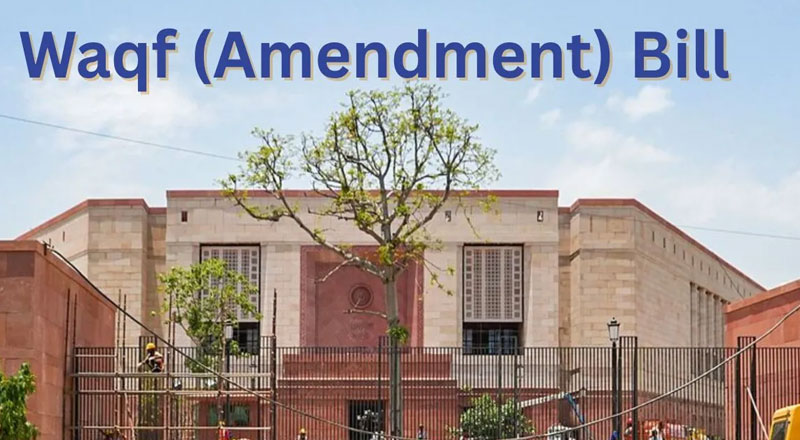The concept of Waqf, a system of Islamic charitable endowments, has evolved significantly over centuries, growing from the donation of two villages by Afghan invader Muhammad Ghori to a massive network of properties across India, now encompassing 9.4 lakh acres. This remarkable journey reflects the historical, political, and social shifts in India and has become a point of focus in contemporary debates around land management and religious endowments.
The Origins of Waqf in India
The story of Waqf in India begins in 1175 when Muhammad Ghori conquered Multan, Punjab, and later defeated Prithviraj Chauhan in the Second Battle of Tarain in 1192. Ghori’s expansion into northern and north-western India marked the beginning of Islamic rule. Among his contributions was the creation of the first recorded Waqf in India in 1185, when he gifted two villages to the Jama Masjid of Multan. The management of these lands was entrusted to a prominent religious leader, a practice that would become central to the Waqf system.
Ghori’s endowment of these villages laid the foundation for Waqf in India, a practice institutionalized by the Delhi Sultanate and subsequent Muslim rulers. Over time, Waqf evolved to serve religious, educational, and community purposes, supporting mosques, madrasas, dargahs, and other welfare initiatives.
Expansion Under the Delhi Sultanate
Under the Delhi Sultanate (13th–16th centuries), Waqf grew significantly as successive rulers institutionalized and expanded the system. Sultans like Iltutmish and Muhammad bin Tughlaq endowed substantial properties to support public amenities such as roads, reservoirs, and madrasas. The Shamsi Masjid in Badayun and the tomb of Qutbuddin in Lahore are prominent examples of Waqf-funded structures.
The administration of Waqf properties during this era was decentralized but well-organized. Local trustees, known as mutawallis, managed daily operations, while higher officials ensured compliance with Islamic principles. The rulers occasionally intervened to correct mismanagement, as seen during Alauddin Khilji’s reign, when reforms were introduced to restore neglected Waqfs.
The Mughal Contribution
The Mughals further expanded the scope and significance of Waqf. Emperors like Akbar and Shah Jahan endowed lands and properties for religious and social purposes. For example, Akbar established Farangi Mahal in Lucknow, while Shah Jahan’s Taj Mahal was partially funded through Waqf endowments, supported by revenues from nearly 30 villages.
Under Mughal rule, Waqf not only flourished in urban centers but also spread to rural India as Muslim communities settled in the countryside. This period saw the conversion of underprivileged populations to Islam, further integrating Waqf into the socio-economic fabric of the subcontinent.
Waqf During the British Era and Beyond
The British colonial administration formalized Waqf with the Mussalman Wakf Act of 1923, which regulated the management of endowments. After India’s independence, the system was further codified through the Waqf Act of 1954, updated in 1995 and 2013. These acts established state Waqf Boards, turning them into major stakeholders in land management.
Today, Waqf Boards collectively manage over 8.7 lakh properties, covering 9.4 lakh acres. This vast landholding includes mosques, schools, hospitals, and community spaces, making Waqf one of the largest landowners in the country, rivaling institutions like the Indian Railways and the Ministry of Defence.
Challenges and the Waqf Amendment Bill
Despite its historical significance, the Waqf system has faced criticism for mismanagement, lack of transparency, and conflicts over land ownership. Cases like that of Rajagopal, a farmer in Tamil Nadu’s Trichirappalli district, highlight these issues. Rajagopal discovered that his 1.2-acre plot, which he intended to sell for his daughter’s wedding, was listed as Waqf land, leaving him and his entire village in disbelief.
Such instances have fueled debates over the powers of Waqf Boards, prompting the BJP-led government to propose the Waqf Amendment Bill. This legislation aims to reform the management of Waqf properties, address grievances, and ensure greater accountability.
A Broader Perspective: The Role of Waqf in India
Waqf has played a pivotal role in India’s cultural and social development. Its contributions to education, healthcare, and public welfare have been significant, creating a lasting legacy. The system reflects the diverse and pluralistic history of India, where religious endowments have supported community development across centuries.
At the same time, modern challenges demand reforms to balance historical practices with contemporary needs. The proposed Waqf Amendment Bill represents an opportunity to modernize the system while preserving its core values of charity and community service.
A System Rooted in History, Poised for Reform
From the gift of two villages by Muhammad Ghori to becoming one of the largest landholders in India, the Waqf system encapsulates a fascinating journey through history. It has supported countless religious, educational, and social initiatives, shaping the nation’s landscape.
As India moves forward, addressing the challenges within the Waqf system is essential to ensuring its continued relevance. By embracing transparency and accountability through reforms, the Waqf Boards can uphold their legacy while adapting to the demands of a modern, democratic society.
(With inputs from agencies)





